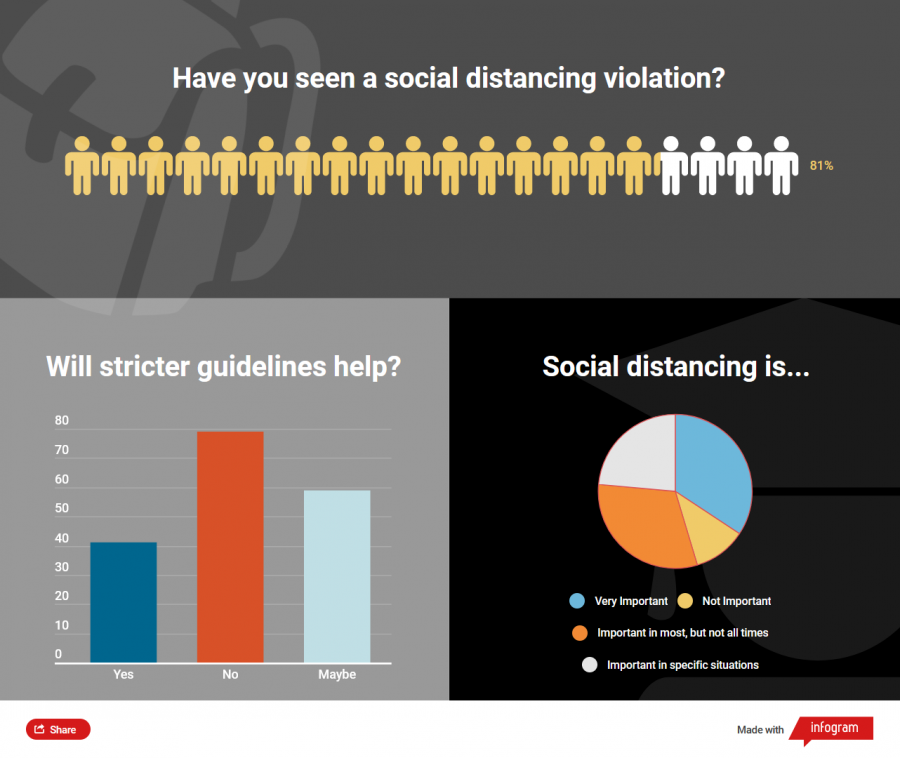Not enforced, not practiced
Social distancing needs stricter regulation in school
Photo by Infographic by Sasha Kek
As a current in-person learner, Shaun Stubenvoll, sophomore, says despite seeing people violating social distancing rules, it is still possible in schools. “Of course it’s possible, and with vaccines coming out by the time we start school next year, hopefully social distancing will be a distant memory,” Stubenvoll said.
“Please keep your masks on and make sure you are social distancing,” the announcements remind students every period. It seems easy enough to wear a piece of fabric over your nose and stay an arm’s length away from others, but with most of the student population back in the building, social distancing becomes more challenging.
The Center for Disease Control (CDC) updated their conditions for in-person learning, including a three-feet apart social distancing regulation and a high recommendation for teachers and staff to get vaccinated.
As a former in-person leaner, I have witnessed students walking with their masks below their noses, or groups of people clumped in the hallways. I must admit, sometimes I cannot help but wonder why the school does not have a surge of COVID cases in such instances, but I always landed on the same cause of the problem: teachers are not enforcing regulations.
A March Bear Facts survey of 280 students revealed 19% think social distancing is not possible, while 46% said social distancing can be possible only if students do their part and teachers enforce the guidelines. With more students in the building, social distancing becomes even more problematic as 81% of in-person survey respondents said they noticed a student or teacher violating protocol.
Such behavior is concerning for students like Kailah Dupee, freshman, who has been in e-learning for the whole school year.
“I will be in e-learning for the rest of the year because I feel that it’s still not safe enough for me or for my family to go back to school,” Dupee said. “I feel too uncomfortable to go back, especially since I’ve seen people not wearing their masks correctly [on Zoom].”
In my case, I switched back to e-learning for the same reason Dupee is in e-learning: my family’s safety. In a sense, I did not mind too much when I saw students not following regulations because it reminded me of a time when life was normal; I was most concerned with teachers turning a blind eye to the clumps of students in the hallway, or the person whose mask was barely covering their mouth. Why are we expected to follow COVID guidelines when adults are not enforcing them?
Despite people’s seeming reluctance to adhere to social distancing, Dupee says she believes social distancing is important because it helps keep others safe “as long as it is being enforced properly.”
“I want to go back to school when it’s safe enough, and if social distancing can help get there faster, I think it’s for the best,” Dupee said. “It’s important to follow COVID regulations because it can help get things to go back to pre-COVID.”
But for some students, education has become more valuable over the past year.
“I am beyond grateful to be in-person; I really took for granted how valuable it is to be able to learn inside a classroom,” Shaun Stubenvoll, sophomore, said. “Online learning was horrible and really put me a step back. Before COVID I was an honors student that would get mostly As with occasional Bs, but last semester I was a student who struggled to maintain Cs. This made me eligible to come in-person full time before most, and I am forever grateful for my counselor Mrs. Cotton for making that happen.”
Stubenvoll says he hopes that come next school year, “social distancing will be a distant memory,” and I could not agree more. I know I am not the only student who can admit that the pandemic gave me a new appreciation for physically being in a classroom rather than communicating over a screen.
There is progress, however: the Pfizer and Moderna vaccines are granted for emergency use by the Food and Drug Administration (FDA), and 89,245,776 – roughly 27% – people in America have been vaccinated as of April 22.
Ultimately, it takes everyone to do their part; COVID is not going away, but taking the necessary precautions like wearing a mask, social distancing, and any other preventative method you choose to take are all ways mankind can get closer to normal life again.
###

This is Sasha’s third and final year working with the Bear Facts staff as the LZ Life Editor. Aside from helping Bear Facts run smoothly, you can find...

